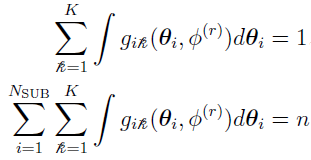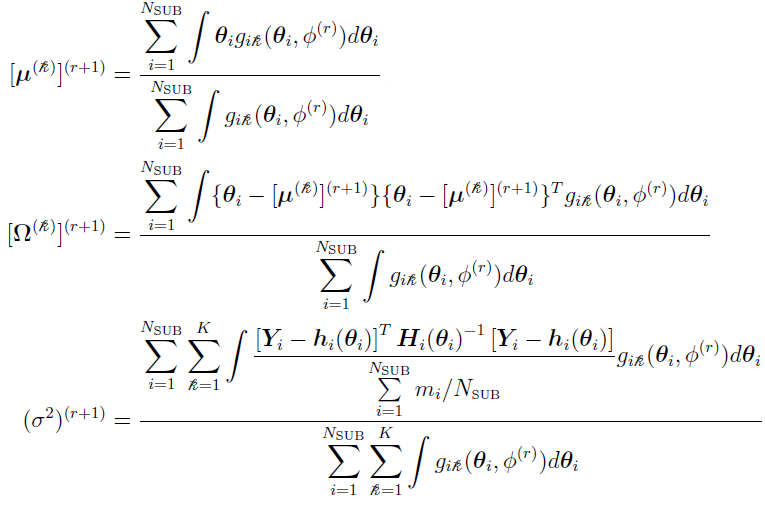In the EM algorithm, both complete data and missing data are defined:
 defines the complete data.
defines the complete data.
{ ,
, } is missing data, where
} is missing data, where  is a K-dimensional vector whose
is a K-dimensional vector whose  th component,
th component,  , is 1 or 0 depending on whether
, is 1 or 0 depending on whether  belongs to the
belongs to the  th mixing in the equation:
th mixing in the equation:

where
 is the weight for the
is the weight for the  th Gaussian distribution
th Gaussian distribution  (nonnegative number, normalized by
(nonnegative number, normalized by  )
)
 is the mean vector (
is the mean vector ( )
)
 is the positive definite covariance matrix (
is the positive definite covariance matrix ( )
)
The purpose of the EM algorithm is to start with  and iterate from
and iterate from  to
to  at the rth iteration, continuing the process until the desired parameters
at the rth iteration, continuing the process until the desired parameters  are identified, such that
are identified, such that

where  is defined and calculated by equations discussed below. This process guarantees convergence to a stationary point of the likelihood [3] [11] [12], and typically, a number of starting positions are suggested in an effort to ensure convergence to a global maximum [3].
is defined and calculated by equations discussed below. This process guarantees convergence to a stationary point of the likelihood [3] [11] [12], and typically, a number of starting positions are suggested in an effort to ensure convergence to a global maximum [3].
The E-Step
During the Expectation Step, the function is defined as  , where the complete data likelihood
, where the complete data likelihood  is given by
is given by

By using Bayes Theorem, the function can be written as [3]

where

and, for some constant C,

Note that the probability that the ith individual belongs to the  th mixing component can be defined as
th mixing component can be defined as

The M-Step
In the Maximization Step, it is sufficient to find the unique solution of  such that
such that

where  . This leads to unique solutions [3] of
. This leads to unique solutions [3] of  . (See the “Solutions” section for details.)
. (See the “Solutions” section for details.)
The updating of  can be calculated as the average of the contributions from each subject to the
can be calculated as the average of the contributions from each subject to the  th mixing [3], i.e.,
th mixing [3], i.e.,

To calculate the log of the likelihood function  in
in

(discussed in “Two-Stage Nonlinear Random Effects Mixture Model”) first evaluate the denominator of  , which does not depend on
, which does not depend on  . Define it as Ni such that
. Define it as Ni such that

where

Once  and Ni are obtained, the earlier equation:
and Ni are obtained, the earlier equation:

can be immediately evaluated by 
The log of the likelihood function  is
is  .
.
The EM iterates  have the important property that the corresponding likelihoods
have the important property that the corresponding likelihoods  are non-decreasing, i.e.,
are non-decreasing, i.e.,  for all r [11] [3].
for all r [11] [3].
Looking at  (from the E-step)
(from the E-step)

leads to the conclusions that

Therefore, the unique solutions [3] of  (from the M-step) can be written as
(from the M-step) can be written as

In a case described in reference [3], the parameter  can be partitioned into two components
can be partitioned into two components  , where
, where
 is from a mixture of multivariate Gaussians.
is from a mixture of multivariate Gaussians.
 is from one single multivariate Gaussian.
is from one single multivariate Gaussian.
The EM updates from  are given by
are given by
